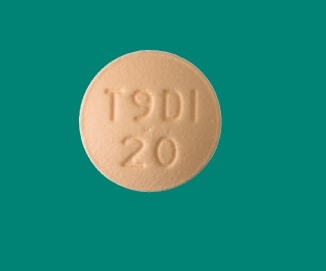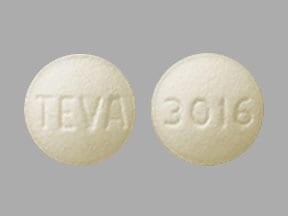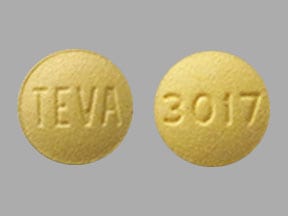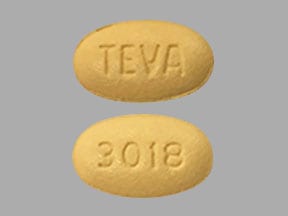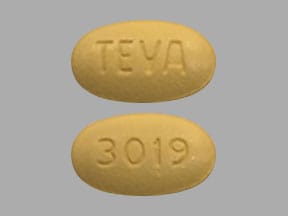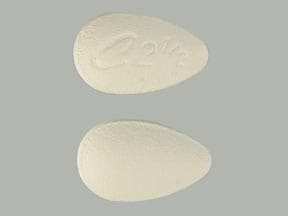Dosage Forms
Excipient information presented when available (limited, particularly for generics); consult specific product labeling.
Tablet, Oral:
Adcirca: 20 mg
Alyq: 20 mg
Cialis: 2.5 mg, 5 mg, 10 mg, 20 mg
Generic: 2.5 mg, 5 mg, 10 mg, 20 mg
Pharmacology
Mechanism of Action
BPH: Exact mechanism unknown; effects likely due to PDE-5 mediated reduction in smooth muscle and endothelial cell proliferation, decreased nerve activity, and increased smooth muscle relaxation and tissue perfusion of the prostate and bladder
Erectile dysfunction: Does not directly cause penile erections, but affects the response to sexual stimulation. The physiologic mechanism of erection of the penis involves release of nitric oxide (NO) in the corpus cavernosum during sexual stimulation. NO then activates the enzyme guanylate cyclase, which results in increased levels of cyclic guanosine monophosphate (cGMP), producing smooth muscle relaxation and inflow of blood to the corpus cavernosum. Tadalafil enhances the effect of NO by inhibiting phosphodiesterase type 5 (PDE-5), which is responsible for degradation of cGMP in the corpus cavernosum; when sexual stimulation causes local release of NO, inhibition of PDE-5 by tadalafil causes increased levels of cGMP in the corpus cavernosum, resulting in smooth muscle relaxation and inflow of blood to the corpus cavernosum. At recommended doses, it has no effect in the absence of sexual stimulation.
PAH: Inhibits phosphodiesterase type 5 (PDE-5) in smooth muscle of pulmonary vasculature where PDE-5 is responsible for the degradation of cyclic guanosine monophosphate (cGMP). Increased cGMP concentration results in pulmonary vasculature relaxation; vasodilation in the pulmonary bed and the systemic circulation (to a lesser degree) may occur.
Pharmacokinetics/Pharmacodynamics
Distribution
Vd: 63 to 77 L
Metabolism
Hepatic, via CYP3A4 to metabolites (inactive)
Excretion
Feces (~61%, predominantly as metabolites); urine (~36%, predominantly as metabolites)
Onset of Action
Within 1 hour; Peak effect: Pulmonary artery vasodilation: 75 to 90 minutes (Ghofrani 2004)
Time to Peak
Plasma: ~2 hours (range: 30 minutes to 6 hours)
Duration of Action
Erectile dysfunction: Up to 36 hours
Half-Life Elimination
15 to 17.5 hours; Pulmonary hypertension (not receiving bosentan): 35 hours
Protein Binding
94%
Use in Specific Populations
Special Populations: Renal Function Impairment
Tadalafil AUC doubled in subjects with CrCl 31 to 80 mL/minute. In patients with ESRD on hemodialysis, there was a 2-fold increase in Cmax and 2.7- to 4.8-fold increase in AUC.
Special Populations: Hepatic Function Impairment
Tadalafil AUC after a 10 mg dose in patients with mild or moderate hepatic impairment (Child-Pugh class A or B) was comparable with exposure in healthy subjects. There are insufficient data for subjects with severe hepatic impairment.
Special Populations: Elderly
Subjects >65 years of age have a 25% higher exposure compared with subjects 19 to 45 years of age.
Special Populations Note
Diabetes mellitus: The AUC was reduced approximately 19% and Cmax was 5% lower in patients with diabetes mellitus than in healthy subjects.
Use: Labeled Indications
Benign prostatic hyperplasia (Cialis only): Treatment of the signs and symptoms of benign prostatic hyperplasia (BPH).
Erectile dysfunction (Cialis only): Treatment of erectile dysfunction.
Erectile dysfunction and benign prostatic hyperplasia (Cialis only): Treatment of erectile dysfunction and the signs and symptoms of BPH.
Pulmonary arterial hypertension (Adcirca only): Treatment of pulmonary arterial hypertension (World Health Organization group 1) to improve exercise ability. Studies establishing effectiveness included predominately patients with New York Heart Association (NYHA) functional class II to III symptoms and etiologies of idiopathic or heritable pulmonary arterial hypertension (61%) or pulmonary arterial hypertension associated with connective tissue diseases (23%).
Use: Off Label
Raynaud phenomenonb
Data from a meta-analysis and a small controlled trial support the use of tadalafil for Raynaud phenomenon related to systemic sclerosis, demonstrating a decrease in the frequency and severity of attacks Roustit 2013, Shenoy 2010. In one small controlled trial, use of tadalafil showed no benefit compared to placebo Schiopu 2009.
Contraindications
Serious hypersensitivity to tadalafil or any component of the formulation; concurrent use of organic nitrate (regularly and/or intermittently) or guanylate cyclase stimulators (eg, riociguat).
Canadian labeling: Additional contraindications (not in US labeling): Previous episode of nonarteritic anterior ischemic optic neuropathy
Dosage and Administration
Dosing: Adult
Benign prostatic hyperplasia (with or without concomitant erectile dysfunction) (Cialis): Oral: 5 mg once daily. Note: When tadalafil is used with finasteride to initiate BPH therapy, the recommended duration of therapy is ≤26 weeks.
Dosing adjustment with concomitant medications:
Alpha1-blockers: Not recommended for use in combination with alpha-blockers for the treatment of BPH.
CYP3A4 inhibitors (strong): 2.5 mg once daily; maximum: 2.5 mg once daily
Erectile dysfunction (Cialis):
As-needed dosing: 10 mg at least 30 minutes prior to anticipated sexual activity as one single dose and not more than once daily. Dose may be adjusted based on tolerability (dosing range: 5 to 20 mg). Note: Erectile function may be improved for up to 36 hours following a single dose.
Once-daily dosing: 2.5 mg once daily at approximately the same time daily without regard to timing of sexual activity. Dose may be adjusted based on tolerability (dosage range: 2.5 to 5 mg/day).
Dosing adjustment with concomitant medications: Oral:
Alpha1-blockers: Patients should be stable on alpha-blocker therapy prior to initiating tadalafil treatment, and tadalafil should be initiated at the lowest recommended dose.
CYP3A4 inhibitors (strong):
As-needed dosing: Maximum: 10 mg, not more frequently than every 72 hours
Once-daily dosing: Maximum: 2.5 mg once daily
Pulmonary arterial hypertension (Adcirca): Oral: 40 mg once daily
Dosing adjustment with concomitant medications:
Concurrent use with ritonavir:
Initiation of tadalafil in patients currently receiving ritonavir for at least 1 week: Initiate tadalafil at 20 mg once daily; increase to 40 mg once daily based on individual tolerability.
Initiation of ritonavir in patients currently receiving tadalafil: Discontinue tadalafil at least 24 hours prior to the initiation of ritonavir. After at least 1 week of ritonavir, resume tadalafil at 20 mg once daily; increase to 40 mg once daily based on individual tolerability.
Raynaud phenomenon (off-label use): Oral: 20 mg every other day. Clinical trials ranged from 4 to 8 weeks as monotherapy or as adjunctive therapy to vasodilator therapy (eg, calcium channel blockers, angiotensin-converting enzyme inhibitor ([ACEI] angiotensin receptor blocker [ARB]) (Shenoy 2010; Roustit 2013).
Dosing: Geriatric
Refer to adult dosing. No dose adjustment for patients >65 years of age in the absence of renal or hepatic impairment.
Extemporaneously Prepared
A 5 mg/mL tadalafil oral suspension may be made with tablets in a 1:1 mixture of Ora-Plus® and Ora-Sweet®. Crush fifteen 20 mg tadalafil tablets in a glass mortar and reduce to a fine powder. Prepare the vehicle by mixing 30 mL of Ora-Plus® and 30 mL of Ora-Sweet®; stir vigorously. Add 30 mL of the vehicle in geometric proportions to the powder and mix to form a smooth suspension. Transfer the mixture to a 2 ounce amber plastic prescription bottle. Rinse mortar with a quantity of the vehicle sufficient to make a final volume of 60 mL. Label “shake well.” Stable for 91 days when stored in amber plastic prescription bottles at room temperature.
Pettit RS, Johnson CE, and Caruthers RL, “Stability of an Extemporaneously Prepared Tadalafil Suspension,” Am J Health Syst Pharm, 2012, 69(7):592-4.22441791
Administration
Oral: May be administered with or without food.
Adcirca: Administer daily dose all at once; dividing doses throughout the day is not advised.
Cialis: Do not split tablets; the entire dose should be taken. When used on an as-needed basis, should be taken at least 30 minutes prior to sexual activity. When used on a once-daily basis, should be taken at the same time each day, without regard to timing of sexual activity.
Storage
Store at 25°C (77°F); excursions permitted to 15°C to 30°C (59°F to 86°F).
Tadalafil Images
Drug Interactions
Alcohol (Ethyl): May enhance the hypotensive effect of Phosphodiesterase 5 Inhibitors. Monitor therapy
Alpha1-Blockers (Nonselective): Phosphodiesterase 5 Inhibitors may enhance the hypotensive effect of Alpha1-Blockers (Nonselective). Management: Ensure patient is stable on one agent prior to initiating the other, and always initiate combination using the lowest possible dose of the drug being added. When tadalafil is used for treatment of BPH, concurrent alpha 1-blockers are not recommended. Consider therapy modification
Alpha1-Blockers (Uroselective): May enhance the hypotensive effect of Phosphodiesterase 5 Inhibitors. Monitor therapy
Alprostadil: Phosphodiesterase 5 Inhibitors may enhance the adverse/toxic effect of Alprostadil. Avoid combination
Amyl Nitrite: Phosphodiesterase 5 Inhibitors may enhance the vasodilatory effect of Amyl Nitrite. Avoid combination
Aprepitant: May increase the serum concentration of CYP3A4 Substrates (High risk with Inhibitors). Monitor therapy
Blood Pressure Lowering Agents: Phosphodiesterase 5 Inhibitors may enhance the hypotensive effect of Blood Pressure Lowering Agents. Monitor therapy
Bosentan: May decrease the serum concentration of Phosphodiesterase 5 Inhibitors. Phosphodiesterase 5 Inhibitors may increase the serum concentration of Bosentan. Monitor therapy
Clofazimine: May increase the serum concentration of CYP3A4 Substrates (High risk with Inhibitors). Monitor therapy
Cobicistat: May increase the serum concentration of Tadalafil. Management: Recommendations for use of tadalafil in patients also receiving cobicistat vary by tadalafil indication and country. See full drug interaction monograph for details. Consider therapy modification
Conivaptan: May increase the serum concentration of CYP3A4 Substrates (High risk with Inhibitors). Avoid combination
CYP3A4 Inducers (Strong): May decrease the serum concentration of Tadalafil. Management: Erectile dysfunction: monitor for decreased effectiveness - no standard dose adjustments recommended. Avoid use of tadalafil for pulmonary arterial hypertension in patients receiving a strong CYP3A4 inducer. Consider therapy modification
CYP3A4 Inhibitors (Moderate): May decrease the metabolism of CYP3A4 Substrates (High risk with Inhibitors). Monitor therapy
CYP3A4 Inhibitors (Strong): May increase the serum concentration of Tadalafil. Management: Recommendations regarding use of tadalafil in patients also receiving strong CYP3A4 inhibitors may vary based on indication and/or international labeling. Consult appropriate product labeling. Exceptions: Ritonavir. Consider therapy modification
Dapoxetine: May enhance the orthostatic hypotensive effect of Phosphodiesterase 5 Inhibitors. Avoid combination
Duvelisib: May increase the serum concentration of CYP3A4 Substrates (High risk with Inhibitors). Monitor therapy
Erdafitinib: May increase the serum concentration of CYP3A4 Substrates (High risk with Inhibitors). Monitor therapy
Etravirine: May decrease the serum concentration of Phosphodiesterase 5 Inhibitors. Monitor therapy
Fluconazole: May increase the serum concentration of Tadalafil. Monitor therapy
Fosaprepitant: May increase the serum concentration of CYP3A4 Substrates (High risk with Inhibitors). Monitor therapy
Fosnetupitant: May increase the serum concentration of CYP3A4 Substrates (High risk with Inhibitors). Monitor therapy
Fusidic Acid (Systemic): May increase the serum concentration of CYP3A4 Substrates (High risk with Inhibitors). Avoid combination
Idelalisib: May increase the serum concentration of CYP3A4 Substrates (High risk with Inhibitors). Avoid combination
Itraconazole: May increase the serum concentration of Tadalafil. Consider therapy modification
Ketoconazole (Systemic): May increase the serum concentration of Tadalafil. Consider therapy modification
Larotrectinib: May increase the serum concentration of CYP3A4 Substrates (High risk with Inhibitors). Monitor therapy
Lorcaserin: May enhance the adverse/toxic effect of Phosphodiesterase 5 Inhibitors. Specifically, the risk of developing priapism may be increased. Monitor therapy
MiFEPRIStone: May increase the serum concentration of CYP3A4 Substrates (High risk with Inhibitors). Management: Minimize doses of CYP3A4 substrates, and monitor for increased concentrations/toxicity, during and 2 weeks following treatment with mifepristone. Avoid cyclosporine, dihydroergotamine, ergotamine, fentanyl, pimozide, quinidine, sirolimus, and tacrolimus. Consider therapy modification
Molsidomine: May enhance the hypotensive effect of Phosphodiesterase 5 Inhibitors. Avoid combination
Netupitant: May increase the serum concentration of CYP3A4 Substrates (High risk with Inhibitors). Monitor therapy
Nitroprusside: Phosphodiesterase 5 Inhibitors may enhance the hypotensive effect of Nitroprusside. Avoid combination
Palbociclib: May increase the serum concentration of CYP3A4 Substrates (High risk with Inhibitors). Monitor therapy
Phosphodiesterase 5 Inhibitors: May enhance the adverse/toxic effect of other Phosphodiesterase 5 Inhibitors. Avoid combination
Posaconazole: May increase the serum concentration of Tadalafil. Consider therapy modification
Riociguat: Phosphodiesterase 5 Inhibitors may enhance the hypotensive effect of Riociguat. Avoid combination
Ritonavir: May increase the serum concentration of Tadalafil. Management: Recommendations regarding use of tadalafil in patients also receiving ritonavir may vary based on indication and/or international labeling. Consult appropriate product labeling. Consider therapy modification
Sapropterin: May enhance the hypotensive effect of Phosphodiesterase 5 Inhibitors. Monitor therapy
Simeprevir: May increase the serum concentration of CYP3A4 Substrates (High risk with Inhibitors). Monitor therapy
Simeprevir: May increase the serum concentration of Phosphodiesterase 5 Inhibitors. Monitor therapy
Stiripentol: May increase the serum concentration of CYP3A4 Substrates (High risk with Inhibitors). Management: Use of stiripentol with CYP3A4 substrates that are considered to have a narrow therapeutic index should be avoided due to the increased risk for adverse effects and toxicity. Any CYP3A4 substrate used with stiripentol requires closer monitoring. Consider therapy modification
Tipranavir: May increase the serum concentration of Tadalafil. Avoid combination
Vasodilators (Organic Nitrates): Phosphodiesterase 5 Inhibitors may enhance the vasodilatory effect of Vasodilators (Organic Nitrates). Avoid combination
Voriconazole: May increase the serum concentration of Tadalafil. Consider therapy modification
Adverse Reactions
>10%:
Cardiovascular: Flushing (2% to 13%)
Central nervous system: Headache (4% to 42%)
Gastrointestinal: Nausea (≤11%)
Neuromuscular & skeletal: Myalgia (1% to 14%), limb pain (1% to 11%)
Respiratory: Respiratory tract infection (13%), nasopharyngitis (6% to 13%)
1% to 10%:
Cardiovascular: Hypertension (1% to 3%), angina pectoris (<2%), chest pain (<2%), facial edema (<2%), hypotension (<2%), myocardial infarction (<2%), orthostatic hypotension (<2%), palpitations (<2%), peripheral edema (<2%), syncope (<2%), tachycardia (<2%)
Central nervous system: Dizziness (<2%), drowsiness (<2%), fatigue (<2%), hypoesthesia (<2%), insomnia (<2%), pain (<2%), paresthesia (<2%), vertigo (<2%)
Dermatologic: Diaphoresis (<2%), pruritus (<2%), skin rash (<2%)
Endocrine & metabolic: Increased gamma-glutamyl transferase (<2%)
Gastrointestinal: Dyspepsia (2% to 10%), gastroenteritis (3% to 5%), gastroesophageal reflux disease (≤3%), diarrhea (1% to 3%), abdominal pain (1% to 2%), dysphagia (<2%), esophagitis (<2%), gastritis (<2%), hemorrhoidal bleeding (<2%), loose stools (<2%), upper abdominal pain (<2%), vomiting (<2%), xerostomia (<2%)
Genitourinary: Urinary tract infection (2%), prolonged erection (<2%), spontaneous erections (<2%)
Hematologic & oncologic: Rectal hemorrhage (<2%)
Hepatic: Abnormal hepatic function tests (<2%)
Neuromuscular & skeletal: Back pain (2% to 10%), arthralgia (<2%), asthenia (<2%), neck pain (<2%)
Ophthalmic: Blurred vision (<2%), conjunctival hyperemia (<2%), conjunctivitis (<2%), eyelid edema (<2%), eye pain (<2%), increased lacrimation (<2%), vision color changes (<2%)
Otic: Hearing loss (<2%), tinnitus (<2%)
Renal: Renal insufficiency (<2%)
Respiratory: Nasal congestion (≤9%), paranasal sinus congestion (≤9%), upper respiratory tract infection (3% to 4%), cough (2% to 4%), dyspnea (<2%), epistaxis (<2%), pharyngitis (<2%)
<1%, postmarketing, and/or case reports: Amnesia (transient global), anterior ischemic optic neuropathy (nonarteritic), basal cell carcinoma (Loeb 2015), cardiovascular toxicity, cerebrovascular accident, hypersensitivity reaction, malignant melanoma (Loeb 2015), migraine, muscle spasm, permanent vision loss, priapism, retinal artery occlusion, retinal vein occlusion, seizure, Stevens-Johnson syndrome, vision loss, visual field loss
Warnings/Precautions
Concerns related to adverse effects:
- Anginal chest pain: Patients experiencing anginal chest pain after tadalafil administration should seek immediate medical attention.
- Color discrimination: May cause dose-related impairment of color discrimination. Use caution in patients with retinitis pigmentosa; a minority have genetic disorders of retinal phosphodiesterases (no safety information available).
- Hearing loss: Sudden decrease or loss of hearing has been reported rarely; hearing changes may be accompanied by tinnitus and dizziness. Instruct patients to seek medical assistance for sudden decrease in hearing or loss of hearing. A direct relationship between therapy and hearing loss has not been determined.
- Hypotension: Decreases in blood pressure may occur due to vasodilator effects; use with caution in patients with left ventricular outflow obstruction (aortic stenosis or hypertrophic obstructive cardiomyopathy); may be more sensitive to hypotensive actions. Concurrent use with alpha-adrenergic antagonist therapy may cause symptomatic hypotension; patients should be hemodynamically stable prior to initiating therapy at the lowest possible dose. Patients should avoid or limit concurrent substantial ethanol consumption as this may increase the risk of symptomatic hypotension.
- Priapism: Painful erection >6 hours in duration has been reported (rarely). Instruct patient to seek medical assistance for erection lasting >4 hours. Use with caution in patients who have conditions which may predispose them to priapism (eg, sickle cell anemia, multiple myeloma, leukemia).
- Vision loss: Vision loss (rare) may be a sign of nonarteritic anterior ischemic optic neuropathy (NAION); causal relationship to PDE5 inhibitors not established. Instruct patients to discontinue therapy and seek medical assistance for sudden loss of vision in one or both eyes. Patients who have already experienced NAION are at an increased risk of recurrence. Other risk factors for NAION include low cup-to-disc ratio ("crowded disc"), CAD, diabetes, hypertension, hyperlipidemia, smoking, and >50 years of age. Use with caution in these patients and only when the benefits outweigh the risks. Safety has not been evaluated in patients with known hereditary degenerative retinal disorders (eg, retinitis pigmentosa); use is not recommended.
Disease-related concerns:
- Anatomical penis deformation: Use with caution in patients with anatomical deformation of the penis (angulation, cavernosal fibrosis, or Peyronie disease).
- Bleeding disorders: Use with caution in patients with bleeding disorders; safety and efficacy have not been established. In vitro studies have suggested a decreased effect on platelet aggregation.
- Cardiovascular disease: Use is not recommended in patients with hypotension (<90/50 mm Hg), uncontrolled hypertension (>170/100 mm Hg), NYHA class II-IV heart failure within the last 6 months, uncontrolled arrhythmias, stroke within the last 6 months, MI within the last 3 months, unstable angina or angina during sexual intercourse; safety and efficacy have not been evaluated in these patients. Safety and efficacy in PAH have not been evaluated in patients with clinically significant aortic and/or mitral valve disease, life-threatening arrhythmias, hypotension (<90/50 mm Hg), uncontrolled hypertension, significant left ventricular dysfunction, pericardial constriction, restrictive or congestive cardiomyopathy, symptomatic coronary artery disease. Use caution in patients with left ventricular outflow obstruction (eg, aortic stenosis, hypertrophic obstructive cardiomyopathy); may be more sensitive to vasodilator effects. There is a degree of cardiac risk associated with sexual activity; therefore, physicians may wish to consider the cardiovascular status of their patients prior to initiating any treatment for erectile dysfunction.
- Hepatic impairment: Use with caution in patients with mild to moderate hepatic impairment; dosage adjustment/limitation is needed. Use is not recommended in patients with severe hepatic impairment or cirrhosis.
- Peptic ulcer disease: Use with caution in patients with active peptic ulcer disease because of effect on platelets (bleeding); safety and efficacy have not been established.
- Pulmonary veno-occlusive disease (PVOD): Pulmonary vasodilators may exacerbate the cardiovascular status in patients with PVOD. Use is not recommended; no clinical data exists in patients with PVOD. In patients with unrecognized PVOD, signs of pulmonary edema should prompt investigation into this diagnosis.
- Renal impairment: Use with caution in patients with renal impairment; dosage adjustment/limitation is needed.
Concurrent drug therapy issues:
- Drug-drug interactions: Potentially significant interactions may exist, requiring dose or frequency adjustment, additional monitoring, and/or selection of alternative therapy. Consult drug interactions database for more detailed information.
- Nitrates: Concomitant use (regularly/intermittently) with all forms of nitrates is contraindicated. Nitrate-mediated vasodilation is markedly exaggerated and prolonged in the presence of PDE-5 inhibitors. When tadalafil is used for BPH, erectile dysfunction, or PAH and nitrate administration is medically necessary (eg, chest pain refractory to other treatments) following the use of tadalafil, at least 48 hours should elapse after the tadalafil dose and nitrate administration. When used for PAH, per the manufacturer, nitrate may be administered within 48 hours of tadalafil. For both situations, administration of nitrates should only be done under close medical supervision with hemodynamic monitoring.
Other warnings/precautions:
- Appropriate use: Potential underlying causes of erectile dysfunction or BPH should be evaluated prior to treatment.
Monitoring Parameters
Blood pressure, response and adverse effects; urine flow, PSA
Pregnancy
Pregnancy Considerations
Tadalafil likely crosses the placenta (Sakamoto 2016). Women with pulmonary arterial hypertension are encouraged to avoid pregnancy (McLaughlin 2009; Taichman 2014). Less than 0.0005% is found in the semen of healthy males.
Patient Education
What is this drug used for?
- It is used to treat erectile dysfunction (ED).
- In men, it is used to treat the signs of an enlarged prostate.
- It is used to treat raised pressure in the lungs.
- It may be given to you for other reasons. Talk with the doctor.
Frequently reported side effects of this drug
- Flushing
- Nausea
- Sore throat
- Stuffy nose
- Common cold symptoms
- Painful extremities
Other side effects of this drug: Talk with your doctor right away if you have any of these signs of:
- Severe cerebrovascular disease like change in strength on one side is greater than the other, difficulty speaking or thinking, change in balance, or vision changes.
- Chest pain
- Fast heartbeat
- Abnormal heartbeat
- Dizziness
- Passing out
- Severe headache
- Vision changes
- Blindness
- Trouble hearing
- Noise or ringing in the ears
- Severe muscle pain
- Severe back pain
- Severe weakness
- Erection that lasts more than 4 hours
- Signs of a significant reaction like wheezing; chest tightness; fever; itching; bad cough; blue skin color; seizures; or swelling of face, lips, tongue, or throat.
Note: This is not a comprehensive list of all side effects. Talk to your doctor if you have questions.
Consumer Information Use and Disclaimer: This information should not be used to decide whether or not to take this medicine or any other medicine. Only the healthcare provider has the knowledge and training to decide which medicines are right for a specific patient. This information does not endorse any medicine as safe, effective, or approved for treating any patient or health condition. This is only a brief summary of general information about this medicine. It does NOT include all information about the possible uses, directions, warnings, precautions, interactions, adverse effects, or risks that may apply to this medicine. This information is not specific medical advice and does not replace information you receive from the healthcare provider. You must talk with the healthcare provider for complete information about the risks and benefits of using this medicine.
